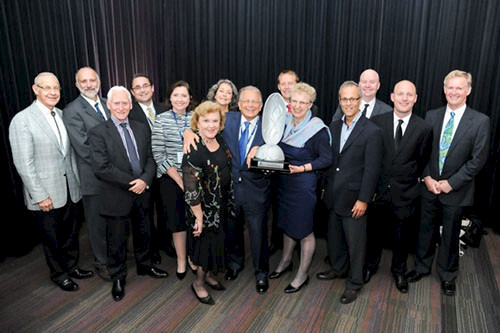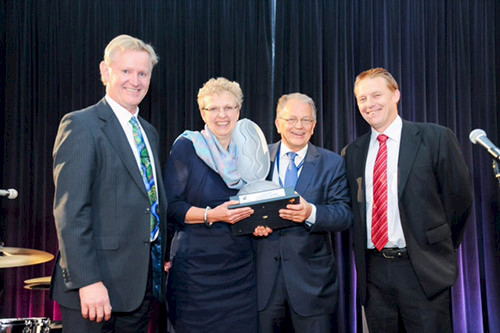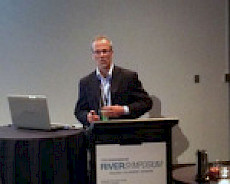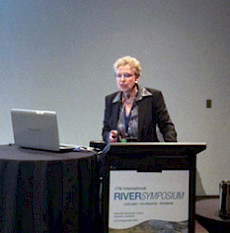Thiess International Riverprize finalists for 2014
Bill Dennison ·The four Thiess International Riverprize finalists provided inspirational examples of creative solutions for river protection and restoration. The winner of the 2014 Riverprize was the International Commission for the Protection of the Rhine, a group of committed and passionate individuals who have transformed the "Sewer of Europe" into a river with high water quality, migratory fish and restored floodplains. There were four very worthy finalists for the 2014 International Riverprize: Glenelg River in Victoria, Australia (2013 Australian Riverprize recipient), Petitcodiac River in New Brunswick, Canada, San Antonio River in Texas, USA, and the Rhine River in various European countries (2013 European Riverprize recipient). At the 2014 International Riversymposium in Canberra, Australia, a session was held for these finalists and this session is summarized here.


1) The Glenelg River case was presented by Adam Bester from the Glenelg Hopkins Catchment Management Authority. The Glenelg River is 500 km long, beginning in the Grampian Mountains and flowing through SW Victoria, Australia, reaching the sea at Nelson. An active restoration program has been ongoing since 2000, focusing on riparian fencing (to prevent cattle and sheep from eroding the stream banks and contaminating the water), revegetation, weed control and erosion control. In addition, various barriers to fish migration have been removed, over half a million trees have been planted, and logs reintroduced into the river to create habitat. A defining feature of this river restoration effort is the partnerships that have been formed between various stakeholders, including the Gunditj Mirring traditional owners.
2) The Petitcodiac River case study was presented by the former Riverkeeper, Daniel LaBlanc. The Petitcodiac River is at the top of the Bay of Fundy, site of the world's largest tides. The Petitcodiac River was renowned for its estuarine fish and the tidal bore that progressed up the river twice a day. However, a causeway was constructed (1964-8) which served to eliminate the tidal bore and led to the elimination of five estuarine fish species, including salmon and shad. Massive silt deposits formed upstream of the causeway. A landfill was constructed along the river upstream of the causeway, further degrading the Petitcodiac River. The Riverkeeper initiated a campaign with four objectives: 1) Communicate a new story for the river, 2) Enforce water quality regulations, 3) Raise funds for legal fees and communication costs, and 4) Percent in back the river. The causeway gated were opened in 2010 and the Petitcodiac River once again runs free, reinstating the tidal bore.


3) The San Antonio River case study was presented by Suzanne Scott from the San Antonio River Authority. The San Antonio River starts in the Blue Hole spring, runs through the seventh largest city in North America, San Antonio and then runs into the Gulf of Mexico. The section of the river within San Antonio supports the popular River Walk, where restaurants, cafes, walking and bike trails line the river, generating $3.1 M dollars annually. Different restoration activities have been initiated along different river reaches. The River Walk length was recently doubled in the Museum Reach. Aquatic habitat has been added, riffles and pools reinstated and riparian vegetation planted in the Mission Reach downstream of San Antonio. The San Antonio River Authority was started in 1937 and has an elected board with access to property taxes for river restoration projects. The river supplies drinking water for San Antonio, and it is a challenge to maintain environmental flows Downstream, particularly in extended droughts.
4) The Rhine River case study was presented by Ann Schulte Wulwer-Leidig from the International Commission for the Protection of the Rhine River. The Rhine River has its origins high in the Alps, flows Into Lake Constance, Switzerland, and on north through Germany and reaches the North Sea in Rotterdam, Netherlands. The river is 2130 km long and eight different countries are involved in the International Commission for the Protection of the Rhine. Ann told us about the 1986 Sandoz accident where a fire in a Switzerland warehouse led to the release of 10-30 tons of toxic pesticides which led to a 400 km massive fish kill. This led to public demonstrations and served as a catalyst for the clean up campaign. And then in 1993 and 1995, the Rhine flooded and 200,000 people were evacuated in 1995. This led to a flood control strategy to be developed. The result of the collective actions in the Rhine has led to reestablishment of fish species like the salmon, Improved water quality, and new flood plain management approaches.


Stuart Bunn, the chair of this session, summarized by saying that these case studies demonstrated innovative ways of addressing challenges, they were all serious long-term efforts, and they had demonstrable impacts of restoration efforts.
I asked the four speakers the question "What are the key elements for initiating programs elsewhere?" The Glenelg River answer was to engage with the community, start somewhere, form partnerships, and leverage funds. The San Antonio answer was to focus on stakeholder needs, gather community leaders (not political leaders) for continuity and develop a funding strategy. The Petitcodiac River answer was to create and articulate a new shared vision, recognize the long time scales needed to effect change, and allow the program to build a life of its own. The Rhine River answer was to build political will and capitalize on events like the chemical spill.
This session drove home the point that each of these divergent case studies solved major challenges, were inspirational in their ability to engage a broad segment of society and they all could point to real improvements in river health. It is a shame that only one of the finalists could receive the Thiess International Riverprize, since they were all winners in what they accomplished.
About the author
Bill Dennison

Dr. Bill Dennison is a Professor of Marine Science and Interim President at the University of Maryland Center for Environmental Science (UMCES).
Next Post > The importance of university child care: Attending the dedication of Munro Center, University of Queensland
Comments
-
victoria secret bikini 10 years ago
This article is in fact a nice one it helps new web users, who are wishing
in favor of blogging. -
Atika 4 months ago
Thank you for sharing this great information with us, i really appreciate your post!